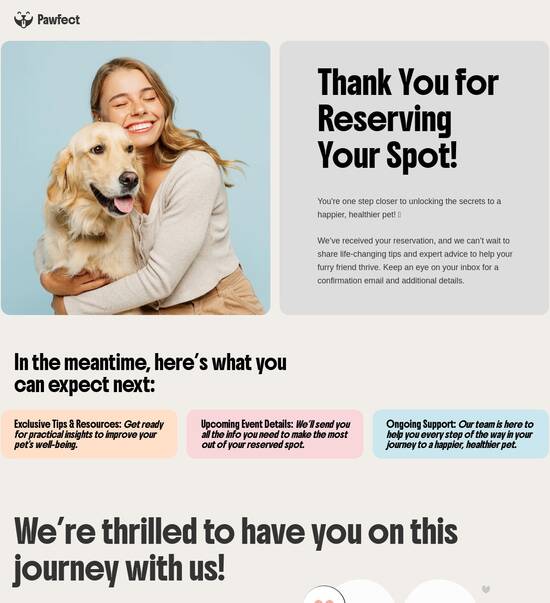
Website Template for Pipeline Management
Explore Similar TemplatesAbout template
Create high-converting landing pages quickly with our Pipeline Management template. Boost conversions, analyze performance, and personalize content for optimal results. Collaborate seamlessly with team members to streamline the page production process.
Recommended templates

Easy to build without coding
With the intuitive drag-and-drop builder, anyone on your team can create high-converting pages without any knowledge of code or design. Make enhancements to your landing page with custom widgets using Javascript, HTML/CSS, or third-party scripts.

Multiple layouts for any industry and goal
Select from 500+ landing page layouts built to boost conversions across industry-specific scenarios. Customize them by adjusting fonts, adding images, and generating on-brand content with the AI assistant. Quickly scale with Instablocks® and Global Blocks that you can save, reuse, and update globally.

Loads fast and looks polished on any device
Every template is responsive, which means they present professionally on any device and load blazingly fast with our Thor Render Engine. You can also power them up with Google AMP technology to deliver an unparalleled mobile experience and drive higher conversions.

Robust analytics & experimentation
Get real-time updates and reporting across all your devices, showing the number of visitors, conversions, cost-per-visitor, and cost-per-lead. Launch AI-powered experiments, run A/B tests, and use heatmaps to analyze user behavior, then optimize your landing page to maximize conversions.







Easy to build without coding
With the intuitive drag-and-drop builder, anyone on your team can create high-converting pages without any knowledge of code or design. Make enhancements to your landing page with custom widgets using Javascript, HTML/CSS, or third-party scripts.
Multiple layouts for any industry and goal
Select from 500+ landing page layouts built to boost conversions across industry-specific scenarios. Customize them by adjusting fonts, adding images, and generating on-brand content with the AI assistant. Quickly scale with Instablocks® and Global Blocks that you can save, reuse, and update globally.
Loads fast and looks polished on any device
Every template is responsive, which means they present professionally on any device and load blazingly fast with our Thor Render Engine.
Robust analytics & experimentation
Get real-time updates and reporting across all your devices, showing the number of visitors, conversions, cost-per-visitor, and cost-per-lead. Launch AI-powered experiments, run A/B tests, and use heatmaps to analyze user behavior, then optimize your landing page to maximize conversions.
All the features you need to build lead-generating landing pages
Explore more featuresLearn how to build top-performing landing pages for any goal
FAQs
Leading the way in building high-performing landing pages





A comprehensive guide to using Instapage for landing page optimization
When it comes to maximizing the ROI of your digital marketing campaigns, utilizing a powerful landing page and CRO platform like Instapage is essential. This guide will walk you through step-by-step instructions to effectively utilize Instapage's features for all types of marketing sectors, including business services, tech/SaaS, and education.
Understanding Instapage's unique value proposition
Instapage is designed to equip marketers with extensive tools that cater to every budget and team size, making it a perfect fit for various industries. Here are three critical aspects of its value proposition:
- Templates & Lead Gen Elements: With over 100 ready-to-use templates, Instapage simplifies lead generation. Each template is conversion-optimized, enabling you to create various landing pages quickly.
- Landing Pages: Instapage’s flexible and user-friendly page creation platform allows for rapid development of landing pages, requiring no coding skills. Users can leverage a library of layouts to launch campaigns effortlessly.
- Optimization: Optimizing landing pages is straightforward with Instapage’s built-in experimentation features. Use heatmaps and analytics dashboards to gather insights and adjust your strategies for better conversions.
Step 1: Creating your landing page
The first step in leveraging Instapage tools is landing page creation.
- Choose a template that aligns with your campaign goals. Options are available for various sectors and objectives, ensuring relevance.
- Utilize the intuitive drag-and-drop builder to modify elements on your page. Customize text, images, and forms without any coding.
- Preview your page across different devices to ensure that it appears optimized for both desktop and mobile users.
Step 2: Optimizing for conversions
Once your landing page is created, focus on conversion optimization.
- Run A/B tests for different versions of your landing page to see which one performs better in terms of conversion rates.
- Monitor heatmaps to identify how visitors interact with your page, helping you make informed tweaks to enhance user experience.
- Utilize Instapage’s analytics dashboard to track overall performance and make data-driven decisions.
Step 3: Personalizing the experience
Personalization is key to achieving higher engagement and conversions.
- Implement dynamic text replacement to tailor your landing page content to visitors' search terms, enhancing relevance.
- Connect your ads to specific landing pages using Instapage’s AdMaps to create a seamless user journey.
- Use segmentation to track unique audience metrics and modify your approach based on the specific needs of different groups.
By following these essential steps, you’ll be well on your way to effectively utilizing Instapage for enhanced landing page performance.
Ready to take your landing page optimization to the next level? Sign up for Instapage today and start crafting pages that convert.
People also ask about Website template for Pipeline Management
Website template for pipeline management: Streamlining your sales process
Understanding pipeline management: The essential role of website templates
Pipeline management is a crucial aspect of any business that relies on sales. It encompasses the systems and processes that a company uses to manage its sales activities, from lead generation to deal closure. A well-designed website template dedicated to pipeline management can significantly enhance these processes, offering a centralized location for tracking and analyzing sales progress. By understanding how pipeline management functions and the unique needs of different businesses, companies can select the right tools to streamline their operations.
The significance of pipeline management for modern businesses
Effective pipeline management is pivotal in driving sales success, as it allows businesses to visualize their sales funnel, prioritize leads, and track progress. In a world where consumers have ample choices, understanding and optimizing the sales process can be the differentiator between winning and losing a sale. For startups, a clear sales pipeline can aid in identifying potential challenges early, while large enterprises can leverage detailed metrics to manage and optimize numerous sales channels. The right pipeline management tool, ideally one represented through a website template, aids in boosting team productivity by offering clear visibility into who is responsible for what and where leads stand in the process.
Moreover, when sales teams can easily access and understand their pipeline, they are better equipped to make informed decisions. A structured sales pipeline, mapped out through an effective template, facilitates proactive management of leads, thereby enhancing overall team performance.
Key elements of a sales pipeline management template
A robust sales pipeline management template is characterized by its structure and key components. It typically involves several layers that detail every stage of the sales process. At its core, a sales pipeline template is designed to be comprehensive yet flexible enough to adapt to unique sales processes. The essential elements include distinct stages, actionable items at each phase, associated probabilities of closing deals, and clear metrics for performance evaluation.
Stages: Clearly defined steps from lead generation to the closing of the deal.
Actions: Tasks that need to be performed at various stages of the sales process.
Probability: Estimations of the likelihood of closing each deal as it progresses.
Metrics: KPIs to assess the performance of the sales pipeline and team effectiveness.
The sales pipeline funnel template plays a pivotal role in managing and visualizing these components effectively. It allows teams to break down the overall journey into digestible stages, making it easier to monitor where leads stand in the process.
Sales pipeline funnel template
The sales funnel stages commonly include: Awareness, Interest, Consideration, Intent, Evaluation, and Purchase. Each of these stages is essential for guiding potential customers through their buying journey. Integrating feedback loops and allowing room for adjustments at each stage is critical. This means that, as leads move through the funnel, the sales team must be prepared to react and refine their approach based on current metrics and results.
Features of website templates for pipeline management
Website templates designed for pipeline management come with a range of features that cater to the diverse needs of sales teams. First and foremost, an intuitive user interface is essential. A user-friendly design enables business owners and team members to navigate the tool easily without a steep learning curve. Customizable layouts are another vital feature, allowing businesses to adapt the template to their specific sales processes and branding.
User-friendly interface: Prioritizes ease of use, ensuring efficiency for all team members.
Integration capabilities: Connects with CRMs, email marketing tools, and analytics platforms for smooth data flow.
Lead tracking and analysis: Facilitates thorough tracking of leads throughout the sales process.
Visualization tools: Provides visual representations of the sales pipeline to enhance understanding and communication.
Integration capabilities are another crucial feature for managing pipeline processes effectively. It ensures seamless data flow between leads and deals, allowing for proactive management. Additionally, templates can provide lead tracking and analysis tools, enabling real-time tracking of progress and timely decision-making. Visualization tools, such as charts and dashboards, enhance the clarity of the sales pipeline, ensuring every team member can quickly grasp the overall pipeline health and performance metrics.
Benefits of using sales pipeline templates
Implementing a sales pipeline management template yields numerous benefits for businesses. Perhaps one of the most significant advantages is enhanced collaboration among team members. A centralized template ensures that everyone has access to the same information, streamlining communication on deal status and responsibilities. This, in turn, fosters a more cohesive approach to managing sales efforts.
Improved decision-making: Data-driven insights empower strategic decision-making.
Efficiency in the sales process: Automating repetitive tasks frees up time for relationship-building.
Comprehensive sales performance insight: Assessing individual and team effectiveness leads to better strategies.
Sales pipeline analysis helps in improving decision-making by leveraging data insights. Companies can adjust their strategies based on performance metrics, leading to smarter decisions that align with sales goals. Templates also drive efficiency by automating repetitive tasks, such as follow-up emails and reminders. This automation allows sales personnel to focus more on building relationships rather than getting buried in administrative duties. Furthermore, a well-constructed sales pipeline management template provides comprehensive insights into sales performance. By evaluating individual and team effectiveness through metrics such as conversion rates and deal sizes, businesses can continuously refine their approach.
Evaluating the impact of a sales pipeline template
When it comes to measuring the success of a sales pipeline management template, tracking specific metrics and KPIs is fundamental. Key performance indicators provide businesses with quantifiable data to determine how well their sales pipeline is functioning. These might include the rate at which leads transition into closed deals, average deal sizes, and the length of the sales cycle.
Transition rates: Metrics that track how effectively leads convert to opportunities.
Sales cycle length: Measuring time taken from lead generation to closing.
Average deal size: Understanding the metrics of revenue per deal.
Scalability and adaptability are another crucial aspect of evaluating the impact of a sales pipeline template. As businesses grow, their processes may change, and the templates used must be adjustable to accommodate new strategies. Customization options allow companies to adapt the pipeline management tool to fit specific business needs, ensuring that it remains relevant and effective over time.
Selecting the right template for your needs
When choosing a website template for pipeline management, it is vital to consider the specific needs of your business size and industry. Different sectors and business scales have unique requirements for managing their sales pipelines. For example, a B2B business may benefit from more complex analytics capabilities, while a B2C operation might prioritize user engagement features.
Assess business size: Understanding the scale of your operation helps in selecting appropriate tools.
Prioritize features: Focus on functionalities aligned with your sales goals.
Seek user feedback: Community insights can lead to better-informed decisions on templates.
Additionally, certain features should be prioritized based on your business objectives, such as lead volume and deal complexity. It is crucial to consider mobile responsiveness and overall accessibility as well. Lastly, user feedback and reviews play an essential role in the selection process. Platforms where users share experiences can be invaluable in highlighting strengths and weaknesses of different pipeline management templates.
Best practices for implementing sales pipeline templates
Implementing a sales pipeline management template successfully requires a strategic approach. Training and onboarding are fundamental in ensuring that all team members understand how to utilize the template effectively. A comprehensive training program should equip teams with the skills to maximize the template's functionalities and efficiencies.
Schedule training: Align sessions with template rollout to ensure smooth adoption.
Regular updates: Incorporate new features and refine processes periodically.
Encourage feedback: Solicit input from users to enhance ongoing performance.
Regular updates to the template are crucial for maintaining relevance and efficiency. Scheduling periodic reviews allows businesses to refine their processes and take advantage of new features that may emerge. Lastly, fostering a culture that encourages feedback will help in ongoing improvements. By actively listening to users and leveraging analytics data, businesses can continuously refine and enhance their pipeline management practices.
Case studies: Successful implementation of pipeline management templates
Studying real-world examples of businesses that have effectively implemented sales pipeline management templates can provide valuable insights. For instance, consider a tech startup that struggled with fragmented communication among its sales team. By adopting a structured sales pipeline template, they were able to centralize information, track progress in real-time, and improve their overall sales efficiency. Through analytics, they identified their top-performing leads and adjusted their strategies accordingly.
Identify inefficiencies: Before adopting a template, assess current limitations.
Implement feedback loops: Use insights to refine the process continuously.
Measure impact: Regularly analyze key metrics post-implementation to assess improvements.
Analysis of their sales processes before and after implementing structured pipeline management reveals significant improvements in closure rates and overall earnings. Such case studies emphasize the transformative power of a tailored pipeline management template, enabling teams to align their efforts and drive results effectively.
The future of pipeline management
As technology evolves, so too will the capabilities of website templates for pipeline management. Trends currently shaping this evolution include increased automation, enhanced analytics, and AI-driven insights. Businesses can expect future templates to integrate deeper analytical tools that provide not just feedback but also predictive insights tailored to optimize sales strategies.
Automation of routine tasks: Streamlining processes further to focus on strategic initiatives.
Integration of AI: Offering predictive analytics to forecast sales outcomes.
Cloud-based solutions: Enabling real-time access and collaboration across various devices.
Predictions for technological advancements suggest that sales strategies will become more personalized and insights-oriented, allowing teams to adapt approaches in real-time based on consumer behaviors and market shifts.
Conclusion: The transformative power of pipeline management templates
In conclusion, sales pipeline templates play an essential role in enhancing business outcomes by providing clear structures for managing sales processes. These templates empower teams to collaborate better, make informed decisions, and ultimately drive revenue growth. As the sales landscape continues to evolve, the flexibility and adaptability of these templates will remain critical for ensuring sustained success. Investing in a robust pipeline management template can significantly alter a business's trajectory, making it a strategic necessity for any modern organization.
Ready to skyrocket conversions?
Supercharge your ad campaigns with high-performing landing pages
Get started














